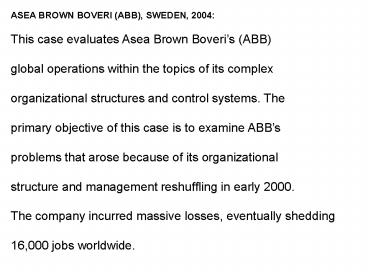ASEA BROWN BOVERI ABB, SWEDEN, 2004:
1 / 9
Title: ASEA BROWN BOVERI ABB, SWEDEN, 2004:
1
ASEA BROWN BOVERI (ABB), SWEDEN, 2004 This
case evaluates Asea Brown Boveris (ABB) global
operations within the topics of its complex
organizational structures and control systems.
The primary objective of this case is to
examine ABBs problems that arose because of
its organizational structure and management
reshuffling in early 2000. The company incurred
massive losses, eventually shedding 16,000 jobs
worldwide.
2
Case Synopsis In the last fifteen years,
academics and business practitioners studying
multinational corporations (MNCs) and global
companies often admired ABB because of its
outstanding growth, sophisticated management,
and peculiar corporate structure.
3
Above all, ABB became famous for its unique
horizontal organizational system and global
networking that was based on lateral
communication across the companys 1,000
entities around the globe.
4
Almost every international management and
international business textbook analyzed ABBs
global structure that incorporated matrix and
other organizational structures based on
decentralization and horizontal systems.
5
Case Synopsis The phrase think global, act
local became synonymous with ABB and its former
chairman, Percy Barnevik who aggressively
advocated and practiced the concept that did very
well in the first ten years but later brought
control problems and weakened operations. For a
long time, the global corporate image and
operations that ABB management projected looked
outstanding although the company had problems in
its matrix and control systems. Eventually, ABB
incurred heavy losses and became a major
liability to stockholders.
6
Discussion Questions 1. What are your views of
ABBs position in the global infrastructure
industry? As discussed in the case, ABB was a
major global player in the infrastructure and
other industrial products. The merger of Asea
and Brown Boveri was a perfect business strategy
since both companies sold complementary products
and targeted the same markets. In the post-merger
era, the company had excellent growth and carried
long-term prospects. In the nineties, the ABB
Group reached to a point where it was a global
force to be reckoned with. Of course, East Asian
markets were ripe for the companys
Infrastructural projects. During the East Asian
Crisis, ABB was poised to add additional non-core
products to its portfolio of 1,000 entities
worldwide. The companys organizational
structure looked solid and its worldwide
operations were benchmarked in studies by
academics and other companies.
7
2. Analyze and evaluate ABBs organizational
structure and its control systems during the
tenures of Percy Barnevik and Jürgen Dormann (see
Figure 1). Also, draw a chart to discuss the
companys strengths and weaknesses. Chart
showing ABBs strengths and weaknesses. The data
can be collected from the company Web site (see
annual reports) and online business publications.
In addition, Figure 1 should be used to compare
and contrast the companys CEOs, Percy Barnevik
and Jürgen Dormann since both sought different
organizational structures and control systems.
Barnevik was infatuated with global expansion
while Dormann was hired to rescue ABB from its
bankruptcy. A good source of information on the
Infrastructural industry can be obtained from
Value Line, Standard Poors Industry Surveys,
Hoovers Company Reports, and other trade
publications.
8
3. What specific strategies does ABB need to
undertake in the coming years to be a key
player in the industry? ABB strategies can be
divided into two areas. In the short-term, the
company should concentrate on seeking new
projects and expand the business opportunities.
In the long-term, ABB should fix its
organizational structure which seems complex and
ineffective. ABB should shed some of its non-core
operations although Dorman has implemented this
strategy by selling oil and gas operations.
Another area which seems important is creating a
new image after Barneviks pension scandal.
9
4. What did you learn from ABBs complex
organizational structure and its global
operations? Regarding organizational structures
and control systems, ABB case is important in
three areas. First, organizational structures are
never permanent. Companies need to reconfigure
and redesign their global operations because of
changing markets and business environments. It is
critical to bring changes from time to time.
Although efficient in some companies, horizontal
and networking-type of organizational systems are
known for their problems at the global level when
companies operate vertically and horizontally. In
the coming years, ABB is expected to regain its
lost markets but the company will never have
those prospects that were available in the
nineties. Finally, it will be interesting to see
if ABBs new management is able to turnaround the
company by seeking alliances and joint ventures
or just keep shedding its businesses to stay
profitable.































